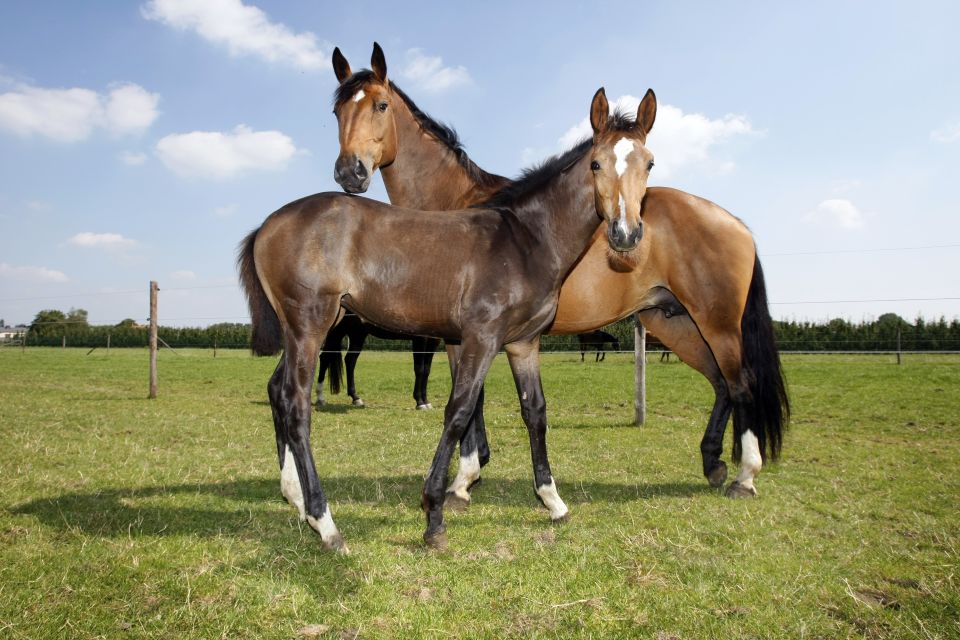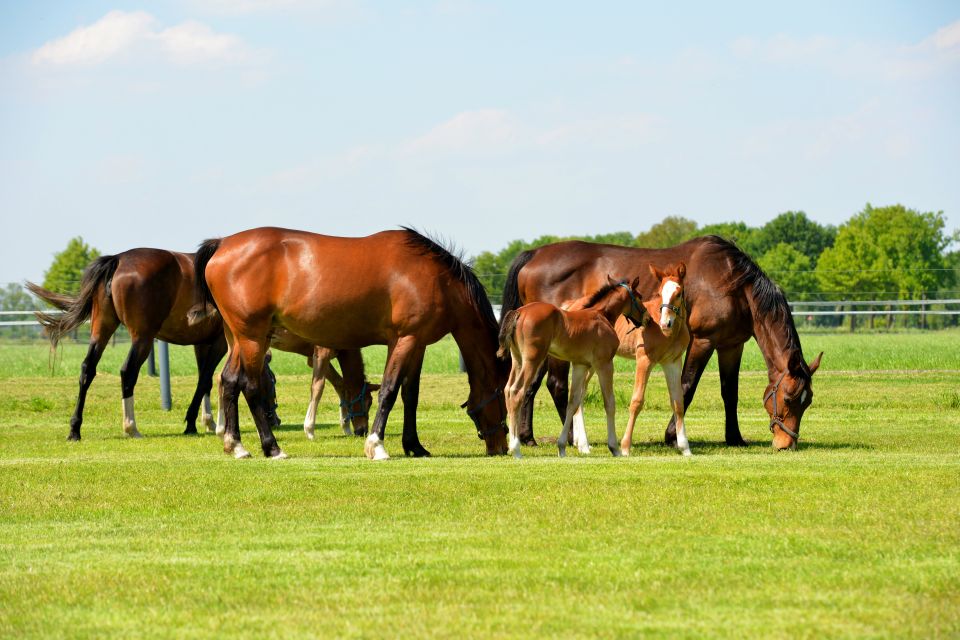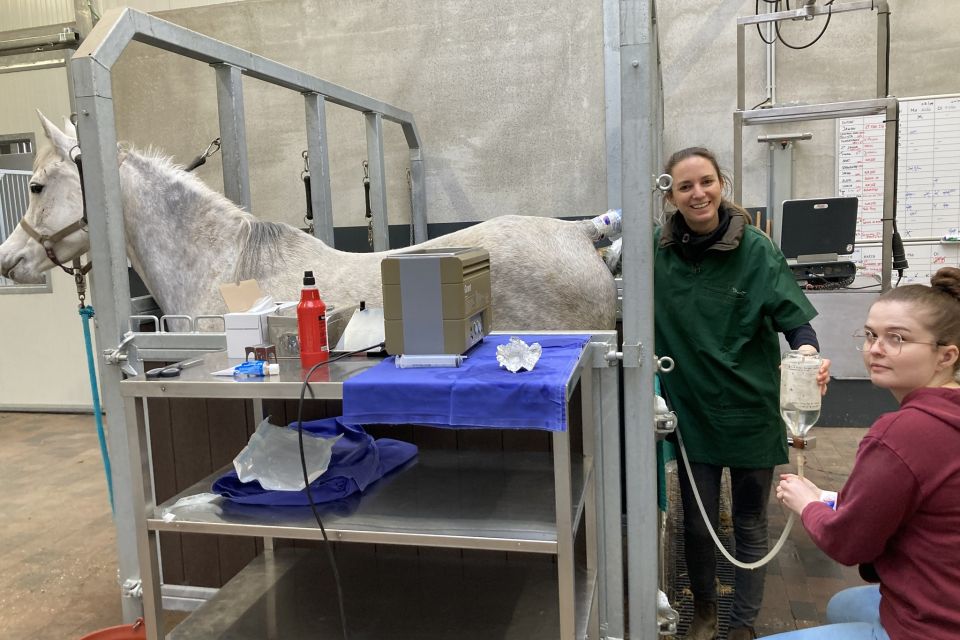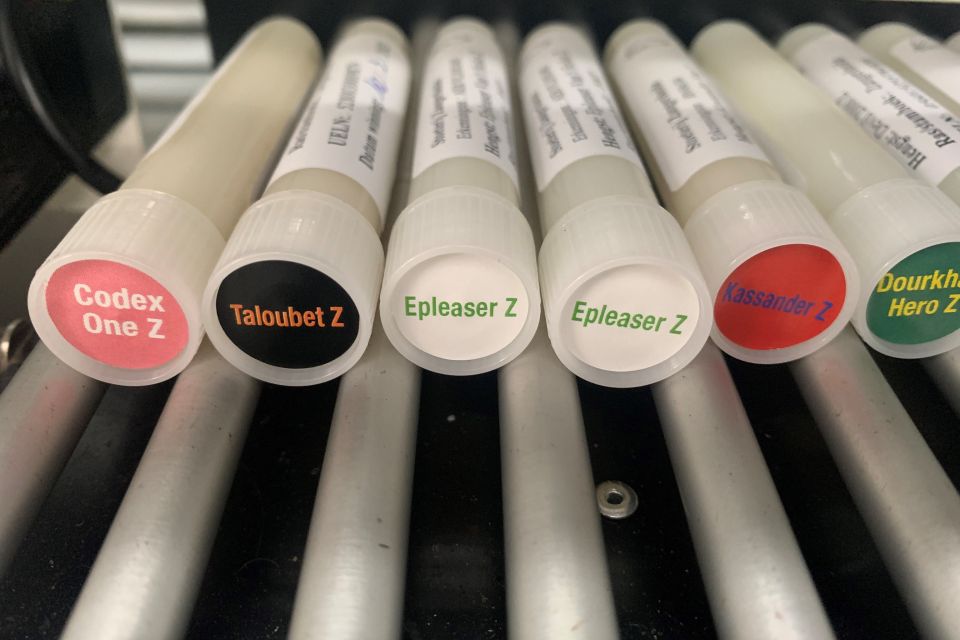19 March '24
The ideal setting for your mare: the insights of veterinarian Marieke Hermans
/
Breeding/
Veterinary
@paardenfotograaf
Lots of exercise in a routine and stress-free environment, combined with enough daylight and a healthy diet. It reads like the ideal world and this is a must for your donor mare as well as recipient mare to achieve the optimal result. The most important season for breeders is on our doorstep. What are the things they need to take into account and consider?
Marieke Hermans has been a fertility doctor for twelve years already and recently took a refreshment course in Newmarket where new scientific insights about broodmares and fertility were on the agenda. Z-Magazine looked over her shoulders.

Healthy mares in good condition start cycling earlier
Cycles of mares come to a standstill in winter. They start cycling again when temperatures rise and the days lengthen. ‘Especially that last aspect is crucial’, Marieke Hermans emphasises. ‘An additional fact is that younger mares start their cycles earlier than older mares. Not just daylight, the body conditioning score plays a part too. Healthy mares in good condition start cycling earlier.’
Health and climate are the starting signal for the new cycle. Showers in March and the whims of April can also have an effect. A few days of sunshine in March can activate the cycle. When this is followed by a a spell of frost it’s perfectly possible that the cycle is put on hold again. ‘The influence of the weather is a natural phenomenon’, Marieke knows: ‘Horses can for instance be affected by heat stress. After a mare has been inseminated and a few days later is confronted with a heat wave that can potentially influence the pregnancy. We always have to speak in terms of conditionality. Frost, heat, condition, light, these are all aspects that can potentially influence the cycle and pregnancy. Although it’s never a black-and-white story since so many factors play an unknown part. We speak of the influence of daylight. If the mare is stabled in a dark space her cycle will most probably start in a different way than for mares out in the field or in a well-lit stable or run-in shed.’
Not every breeder is in a position to turn their mare out in the field in February, March. In such cases light therapy can be an alternative. Homogenous lighting in the stable, sixteen hours a day, can influence the cycle. For some breeders that is an option when they want a foal early in the season.
The ideal time for foals to be born is the spring: ‘An early foal is possible if the breeder has the accommodation for it, which means a good, spacious and warm stable. Breeders who only have a field and sheltering barn at their disposal are strongly advised not to opt for an early foal. The same applies to late foals. Usually, the mare’s cycles continue until September through to October. That implies the possibility of a foal in September of the next year. Not an ideal scenario. That foal will have just a few weeks of turnout in the field. Plus, your foal will then be the youngest of his year collection. What’s going to happen after weaning? He’ll be the youngest foal in his group of peers who are six months older. That is a big difference at that age.’

Fatty acids are supplements, not wonder agents
Nature and climatological circumstances have an influence on the cycle, but it’s just as important that your mare in herself is ready to start the cycle. That specifically means that she needs to spend her days in a stress-free environment. Preferably in a meadow with good pasture. When she’s lacking in condition it’s an option to feed her extra with a maintenance mix. The energy content of that extra feed should not be too high. If you’re looking to add energy then do it with fats and proteins. Maize or corn oil is a possibility, corn silage is a definite no. Recent studies have shown that feeds with too much starch content have a negative influence on the gestation.
This is noticeable in sport mares who are flushed. They are often fed a diet rich in starch which causes a higher death rate in the transfer of their embryos. So feeding is another decisive factor. And that works two ways. Too skinny and too heavy can both negatively impact the success percentage of gestation. In other words, make sure your mare is in optimal condition before insemination.’
‘You can possibly add Omega 3 and 6 fatty agents to the diet, often in the shape of fish oil. Note: fish oil may be contaminated with heavy metals (lead/quicksilver) so it’s wise to track down the source of the oil. Omega 3 and 6 are also present in vegetable oils such as rape oil, linseed oil, sunflower- and corn oil. A good balance between the Omega 3 and 6 is also vital (e.g. linseed oil contains Omega 3, corn oil mainly Omega 6. To make it even more difficult, not every oil has the same quality). This is administered in the period before the mare’s first heat. Important to remember: fatty acids are supplements, not wonder agents.’
Feeding and stress do not just have a short-term impact (pregnant/not pregnant) but also impact the foal’s health and development. A seriously underweight mare may become pregnant but will produce a smaller foal. Even mild malnutrition can have long-term effects on the foal.
An optimal condition can also be disrupted by endocrinological disorders such Cushing’s disease and EMS or Equine Metabolic Syndrome, that interfere with the pregnancy. But that has to be diagnosed and treated by your veterinarian.

Influence of the herd on fertility
A recent study has revealed that it also helps when the mare lives in a herd with other mares. Actually, there are mares who struggle to come into season because they live a solitary life. If such a mare is taken to an AI centre it often happens that the mare comes into season, which is triggered by the presence of other mares and stallions. Cycles start earlier in mares who are stabled in the vicinity of a stallion. In case the presence of the stallion causes too much stress then his presence is counterproductive.
It works the same way for stallions. If they have a low semen production and are subsequently relocated to a stable with mares, the volume of their semen production usually increases. The herd can influence fertility. Pheromones also play a role. Horses too need to find a match. Fun fact: a study has shown that pregnancy percentages went up when the mares are exposed to an, in terms of MHC type, compatible stallion (compatible in this context means a different MHC type), no matter which semen is used for insemination. So when an MHC-compatible stallion is close by they also become pregnant more easily with the semen from a non-MHC-compatible stallion. (MHC, Major Histocompatibility Complex, is a group of genes that code for certain proteins of the immune system. Horses too are instinctively attracted to a different MHC type in order to achieve variety in genes of the immune system).
But let’s assume that our mare leads a healthy and happy life, then she ovulates every three weeks. Many breeders monitor the cycle of their mare and know if their mare has (ir)regular cycles.
‘Let’s say that the mare did not get in foal the previous year, then I advise breeders to consult a veterinarian when the mare is in season. Then a check-up can be organised: an ultrasound of the uterus and ovaries. A uterine swab can also tell us a lot. For example if there might be an infection? And just as important: checking the shape of the vulva. If this is not correct air can be sucked in and contaminate the uterus as well as disrupt implantation of the embryo. This can be remedied with a vulvoplasty/Caslick’s. Basically, this can be done shortly after insemination but if this disorder is corrected before monitoring of the mare it often means you have won an extra season.
I advise fresh semen for mares who are inseminated for the first time
Your veterinarian isn’t interested in your stallion choice. He or she is more interested in whether or not you choose fresh or frozen semen. ‘Because with frozen semen supervision is a lot more intensive and therefore more expensive. Mares who receive frozen semen are usually taken to an AI centre. When it’s the mare’s first time I advise fresh or freshly-cooled semen. What we call fresh is nearly always freshly-cooled which means collected, processed, cooled and dispatched on the day. As a rule the chances of pregnancy are higher with fresh semen. In scientific literature they talk about a success rate of 55-65% per cycle when fresh semen is used and 45-55% when using frozen semen.’ And as always, every statement requires a nuance: ‘fresh semen usually impregnates better than frozen semen but in some cases the 10-year-old frozen semen of that same stallion is better than the present, fresh semen that is on offer.’
‘There are some other considerations that breeders have to factor in. If this is a first time for the mare it's a good idea to inquire after the conditions for the stallion. Some stallions can only be used by buying straws. If the insemination then fails, you have lost everything. Other stallions are available at a live-foal guarantee or you only need to make a down payment with the right to try another time if the mare doesn’t get pregnant. Those conditions also make up part of your stallion choice.’

The first time
When it’s the very first time then Marieke Hermans prefers 3-year-old mares. ‘Starting at age two or three, opinions differ on that. I won’t refuse a client with a 2-year-old mare but personally I would wait for the mare to turn three. It all depends on the mare’s state of development. And considering this young age, I definitely wouldn’t aim for an early foal.
The ideal age for a broodmare lies between three and twelve years old. And rather an 18-year-old mare who has carried a foal before than a 14-year-old mare who has never gestated before. The older the more work for the veterinarian. Older mares that are inseminated for the first time may show a stronger reaction to the semen. Another observation is that those same old mares, if they carry the foal themselves, usually give birth to smaller foals. This is because the mucous membrane of the uterine wall is tougher which makes the blood supply via the uterine wall more difficult. Therefore I advise flushing of embryos when dealing with older mares. Still, reproduction is never a black-and-white story, it all depends on your mare. Twenty-year-old mares internally sometimes look ten years younger on scans. And I also see the reverse. Some mares are flushed one week before a Nations Cup and jump clean rounds. But definitely not all. There are mares that cannot combine sport and flushing. The reason why is as yet unknown. There are so many unidentified factors that play a role.’
Change from heaps of attention to turnout at pasture
We already mentioned the importance of routine and a stress-free environment. ‘A sport mare turned broodmare suddenly finds herself in a totally different setting. It’s a sudden change from heaps of attention to turnout at pasture. Those mares don’t understand what’s happening to them and that change of environment triggers stress. Which often translates into not getting pregnant the first year because they’re mentally not ready for it.’
Freshly-won semen
When the fresh semen is delivered to the breeder it must be stored in the fridge. Unless the semen is delivered with ice-packs, then storing it in the fridge is not per se necessary. As a rule, semen is collected in the morning for insemination on that same day. Every veterinarian prefers working with freshly-won semen. ‘We have to inseminate as closely as possible to the moment of ovulation and hence we need to know how old the semen is. We strongly prefer to have all this information before we start monitoring the mare so that we can tweak her cycle in accordance with the availability of the semen, which remains in good condition for up to 36 – 48 hours. So that's the great advantage of frozen semen, timing is less important.’ Timing of insemination plays a bigger part in case of frozen semen, the timing of semen collection less so.
On average a one-in-two chance for success at the first attempt
As indicated before, the success percentage for pregnancy at the first attempt is around 50%, or a one-in-two chance. ‘There is always a reason, although we don’t always know what it is. Nature is not tangible. How do genetic defects come about? We check for pregnancy seventeen days after insemination. What has happened in the mean time? It is difficult, even impossible to diagnose that.’
There would be far fewer horses if every breeder stopped after just one attempt. ‘So we wait for the next season and start all over again. And we do a check-up. The day after the insemination we don’t just look for the ovulation but also check the uterus. Some mares strongly react to semen, what in the jargon is called Post Breeding Endometritis, which freely translates into an inflammatory reaction in the uterus. Obviously, that has to be treated first. Conception takes plays in the Fallopian tube and the embryo descends into the uterus after five to six days. If the uterus happens to contain fluid or harbours an infection, the embryo has no chance. Normally the problem is solved by the mare, that’s a natural process. And sometimes we have to help by cleaning the uterus.’
Outside is always better than inside
‘New studies have disclosed that exercise is the best therapy if the uterus contains fluid after insemination. Standard treatment for fluid in the uterus is a lavage or injecting oxytocin which causes uterine contractions that drain the fluid. Now however, it has materialised that exercise is the most effective, which requires some effort on the part of the breeder. Keeping the mare stabled up is the easy option, but taking her for a walk or turning her out in the field is better. Outside is always better than inside, is the conclusion.
Flushing embryos does not upset the hormonal balance
After five to six days the embryo descends into the uterus. Which explains why flushing for embryo transfer is done on day seven or eight. At that moment the embryo has not yet nestled into the uterus and the mare has no idea she is pregnant. That takes the edge off the argument that ET equals an abortion. The embryo has merely descended into the uterus and is then flushed out. So flushing embryos does not at all upset the hormonal balance.’
Forcing the mare into season is a natural process
‘The only thing I wish to point out is that we should avoid the extremes when practising ET. After flushing we inject the mare to bring on the heat. Nature ensures that the uterus of a mare in season has a high level of resistance. That’s a logical reaction, since a penis and semen are foreign entities for the mare, who subsequently neatly purifies her uterus after impregnation. The thing is however, that when a mare is flushed, she is not in season and therefore she doesn’t have that high level of resistance. Even when we make sure conditions are as sterile as possible, flushing represents a manipulation inside the mare and the uterus may become contaminated with something. Therefore the mare is forced into season by injecting a hormone, which the mare also produces herself, to break down the yellow body (corpus luteum) and trigger a new cycle that purifies the uterus. Forcing the mare into season is a natural process. The only difference being that people instead of the mare decide when it happens. Obviously, these processes are only used moderately and after thorough considerations.’
‘Another reason to force a mare into season is to avoid an unwanted pregnancy. Then we’re talking about sport mares that are used for ET. There is always a possibility that the embryo stays behind in the uterus in spite of flushing. If the mare is active in the sport people don’t want her to carry a foal to term. That can be prevented by forcing the mare into season after flushing.’
Never say ‘she’s only a surrogate mare’
The process of ET involves the transplantation of an embryo into a recipient or so-called surrogate mare, who requires special attention too. For optimal fertility of a mare her condition, health and a stress-free environment are crucial. Those conditions also apply to the surrogate mare. ‘Your surrogate mare needs to get the same level of attention as your donor mare. A healthy foal requires a healthy mare. Never say ‘she’s only a surrogate mare’.
Not even after foaling. She has completed her job and sometimes she then gets overlooked. It’s a shame this still happens, no matter whether the surrogate mare was bought or hired.’
The success percentage for foal heat is significantly lower
After the birth comes the foal heat: that first season after foaling manifests itself already one week after the delivery. The first ovulation takes place around ten days after foaling. ‘Generally speaking, it’s possible to use that first season but personally I’m not in favour of this practice. The uterus is not yet ready for it, which stands to reason because it still contained a foal only ten days before. And anyway, statistically the success rate of the foal heat is significantly lower and the percentage of embryonic death is higher. So speaking of optimal circumstances for the mare this is definitely not an optimal situation. Especially if there were complications at foaling (e.g. the afterbirth took a long time to come) the foal heat is a no go.
Is it better for mares to carry their first foal themselves? ‘There is no scientific literature to back that up. Personally I’m in favour because it means the mare’s integral fertility process has already once come into action. Assume that a sport mare turns broodmare after her sport career. Experience has shown that pregnancy is easier and more straightforward for mares who have carried a foal to term before. In mares of around 15/16 years old who have never been pregnant we see that the connective tissue of the uterus is much tougher and less elastic. That has negative consequences in many respects. Purifying of the uterus for instance is a lot more difficult and complicated which means that more fluid and dirt stays behind. That in turn negatively influences gestation. Now I’m talking in my capacity as a veterinarian. Breeders and owners may have different thoughts on this. Maybe the breeder finds it too risky to let his valuable mare carry her foal herself? Or he wants to sell the mare at a young age when she’s well-schooled and therefore there’s no time for her to carry a foal first? Veterinarians, breeders, owners, everyone has their reasons and these are all equally valid. We veterinarians try to create the optimal circumstances for your mare, although we also realise that no one has a monopoly on wisdom. Nature still hasn’t entirely divulged all her secrets.